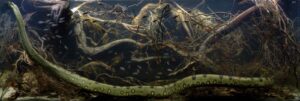River Bank of Rio Olho d’água, Rio da Prata in Mato Grosso do Sul, Brazil
_st place in Biotope Aquarium Design Contest 2022

Volume of aquarium: 840 litres
Dimensions of aquarium: 185Χ65Χ70 cm
List of fishes: Eunectes murinus,Moenkhausia bonita,Hyphessobrycon eques,Hyphessobrycon melanostichos,Hyphessobrycon megalopterus,Eigenmannia virescens
List of plants: none
Description of Decorations and Substrate: Lot of branches and wood similar to those found in the natural biotope. The overall decoration is very dense but also very simple,being consisted of leaf litter some limestone and fine sand recreating the natural environment.
Description of Equipment: 2 X 1850 ltr/h EHEIM professional external filters, 2 X 300 watt EHEIM Thermocontrol, EHEIM powerled , reverse osmosis
Water Parameters: The temperature is about 26° C ,ph 7.4 Conductivity 200-240ppm
Additional Info: 30% water change 5 days
Aquarium video:
Description of the Area Surrounding the Biotope: Rio Olho d’água is the tributary of Rio da Prata, which is located in Mato Grosso do Sul, on the border with Bonito. Rio da prata its in Brazil, specifically the state of Mato Grosso do Sul, which is in inland Brazil. The region borders Paraguay and Bolivia in the west.
With an area of over 350,000 sq km, it is roughly the size of Germany, but it is very sparsely populated. The capital city is Campo Grande with nearly 800,000 inhabitants. Almost a third of Mato Grosso do Sul is marshland, known as the Pantanal. It is one of the biggest wetlands on Earth and has been protected as a world heritage site since 2000! The area around the small town of Bonito is situated just south of the Pantanal, around 300 km away from the capital of Campo Grande.
The Rio da Prata River is the third cleanest river in the world. In addition to hiking through the rainforest and watching 234 species of birds, snorkeling in the lower reaches of the river and enjoy watching as many as 56 species of fish is also a good choice
Description of the Underwater Landscape of the Biotope: The substrate of the river is fine white sand. There are a lot of limestone on the surface of the riverbed. Since the river water is naturally filtered by limestone, and impurities are deposited in the riverbed, the water is very clear and transparent.
there are no plants in most areas of the river. Roots, branches and leaves fall to the river and gather in the slow-flowing area, which provide shelter and additional food source for inhabited fishes.
Description of the Habitat Parameters: The temperature in Mato Grosso do Sul is 26 °C. The highest temperature is in December, February and March, and the summer water temperature is about 25-26 °C. The water at the source of the Olho D’Água River has a constant temperature of 24° C throughout the year.The riverbed contains a lot of limestone and the pH is around 7.4 in dry season. During the rainy season, rising rivers will flood some of the plants and soil on the shore, pH will go lower
List of Fishes and Invertebrates Occurring in the Nature Biotope: Moenkhausia bonita,Hyphessobrycon eques,Hyphessobrycon melanostichos,Hyphessobrycon megalopterus,Eigenmannia virescens, Moenkhausia sanctofilominae,Hemigrammus lunatus
List of Plants Found in the Nature Biotope: Heteranthera zosterifolia ,Helanthium bolivianum,Hydrocotyle verticillata
Threats to the Ecology of the Biotope: The aquarium was created in order to highlight the problems in the Amazon region regarding the ecological side
Sources of Information:
https://mp.weixin.qq.com/s?__biz=MzA4NzU2MzU5NA==&mid=2459180873&idx=4&sn=0cd3c631d51fcf13a25c48f749cc23cf&chksm=8757336cb020ba7af92195655e99b66bfc3074e67eab25d8d9a3b96b833df9744b26cb4a19dc&token=183480784&lang=zh_CN#rd
https://dennerle.com/en/service/travel-report/brazil-2010/rio-da-prata
https://www.fishbase.de/
https://en.wikipedia.org/
https://championtraveler.com/dates/best-time-to-visit-bonito-mato-grosso-do-sul-br/
